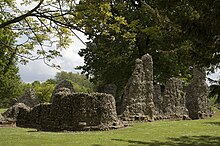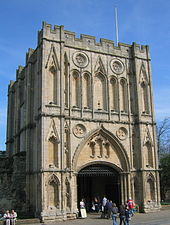St Edmund Abbey
The Bury St Edmunds Abbey was one of the most Benedictine monasteries in England. Their ruins are in Bury St Edmunds in Suffolk .
history
When the remains of King Edmund the Martyr were transferred from Hoxne to Beodricsworth in the early 10th century, what would later become known as Bury St. Edmunds had been a religious center for three centuries. In 1020 the small group of monks guarding the shrine was given the land around it. During the reign of King Canute the Great , monks from St Benet Abbey , Norfolk , came under the auspices of the Bishop of Norwich , among them the first two abbots of the monastery, Ufi, Prior of Holme († 1044), who was appointed by the Bishop of Londonwas ordained abbot, and Leofstan (1044–65). After Leofstan's death, Baldwin, the king's doctor, succeeded him (1065–97). Baldwin had the church rebuilt and in 1095 the saints were buried in it in a grand ceremony. The cult of Edmund made the abbey, richly gifted mainly by Eduard the Confessor , which soon owned a third of Suffolk, a popular destination for pilgrims.
In the 11th and 12th centuries the abbey church was rebuilt in the shape of a cross, Edmund's shrine was located behind the main altar. At 154 meters long and 75 meters wide, it was one of the largest churches in the country. St James's Church, now Bury St Edmunds Cathedral, was completed around 1135. St Mary's Church dates from around 1125 and was rebuilt in 1425–35 in Perpendicular Style .
Abbey Gate, which provided access to the Great Courtyard, was the secular entrance to the monastery used by the servants. In 1327 it was destroyed by the local population during the Great Riot , but rebuilt. Norman Gate dates from 1120 to 1148 and was the entrance to the abbey church and is still the bell tower of the Church of St James, now the cathedral. This four-story entrance hall is practically unchanged.
The abbey included extensive property and other rights in Suffolk. They guarded the gates of Bury St Edmunds, were the guardians of all orphans, whose income went to the abbot until they came of age. She was entitled to forced labor . General prosperity in the 13th century benefited political stability, which gave way to popular hostility in the 14th century. In the summer of 1327 some monks were killed in riots and many buildings were destroyed. The abbey's hated statutes and lists of debtors were destroyed. Declining income led to the abbey's decline in the first half of the 15th century. In 1431 the west tower of the abbey church collapsed. Two years later, King Henry VI. Christmas and the following months in the abbey. In February 1447, Humphrey, Duke of Gloucester , died in unexplained circumstances in Bury St Edmunds. In 1465 the entire church burned down, it was rebuilt by 1506. In 1539 the English monasteries were dissolved . As a result, the abbey lost everything that was valuable about the buildings and their contents, and was finally left to local contractors to be cannibalized.
The ruins of the monastery are part of the English Heritage and were administered by St Edmundsbury Borough Council.
Individual evidence
Web links
- Abbey website
- "Houses of Benedictine monks: Abbey of Bury St Edmunds," A History of the County of Suffolk : Volume 2 (1975), pp. 56-72
- English Heritage website
- Article in the Catholic Encyclopedia
Coordinates: 52 ° 14 ′ 38.8 " N , 0 ° 43 ′ 9.1" E

